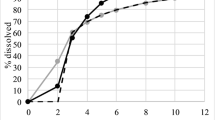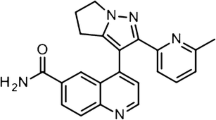Abstract
Purpose
The aim of the present work was to classify metaxalone according to the Biopharmaceutics Classification System (BCS), to develop a clinically relevant dissolution method that can be used to predict the oral absorption of metaxalone and to establish an in vitro-in vivo correlation (IVIVC).
Methods
Solubility of the drug was studied in different pH media and permeability studies were performed using a Caco-2 cell model. The in vitro dissolution and in vivo disposition of metaxalone from 3 different immediate release (IR) tablet formulations were investigated using USP 2 apparatus and a single dose, four-way, crossover bioequivalence study in healthy humans along with an oral solution of the drug, respectively. An IVIVC was established by using a direct, differential based method.
Results
Metaxalone has been confirmed as a Class II drug according to BCS. Bioavailability studies performed in humans demonstrated that dissolution was the rate limiting step for bioavailability of the drug and one of the test products had significantly improved bioavailability compared to the marketed product Skelaxin®. An IVIVC model was developed that demonstrated an acceptable internal predictability.
Conclusion
The IVIVC demonstrated that formulation factors play a significant role in dissolution and absorption of metaxalone. A pH 4.5 dissolution medium containing 0.5% NaCl with 0.2% SLS (USP apparatus 2 at 50 rpm) is clinically relevant to predict bioavailability of the drug and is superior to the USP method in terms of the Quality by Design (QbD) concept.






Similar content being viewed by others
Abbreviations
- AB:
-
Apical to basolateral
- ANOVA:
-
Analysis of variance
- AUCt :
-
Area under the curve from time zero to time of last non-zero concentration
- BA:
-
Basolateral to apical
- BCS:
-
Biopharmaceutics classification system
- Caco-2:
-
Human colonic adenocarcinoma cells
- Cmax :
-
Maximum observed concentration
- DDE:
-
Direct, differential equation
- DMEM:
-
Dulbecco’s modified Eagle's medium
- EMA:
-
European medicines agency
- FDA:
-
Food and drug administration
- HEPES:
-
Hank’s balanced salt solution
- HPLC:
-
High pressure liquid chromatographic
- HPMC:
-
Hydroxypropylmethyl cellulose 6cp
- ICH:
-
International conference on harmonization
- IR:
-
Immediate release
- IVIVC:
-
In vitro-in vivo correlation
- K2EDTA:
-
Dipotassium ethylenediaminetetraacetic (edetic) acid
- LC MSD:
-
Liquid chromatography with mass spectrometry detection
- LLOQ:
-
Lower limit of quantification
- NEAA:
-
Nonessential amino acids solution
- PE:
-
Prediction errors
- PK:
-
Pharmacokinetic
- PVP:
-
Povidone K30
- QbD:
-
Quality by design
- QC:
-
Quality control
- SLS:
-
Sodium lauryl sulfate
- TEER:
-
Transepithelial electrical resistance
- USP:
-
United States Pharmacopeia
- UV:
-
Ultraviolet
References
U.S. Department of Health and Human Services, Food and Drug Administration, Center for Drug Evaluation and Research (CDER). Waiver of In vivo bioavailability and bioequivalence studies for immediate-release solid oral dosage forms based on a biopharmaceutics classification system. 2000.
European Medicines Agency. Guideline on the investigation of bioequivalence. 2010. (EMA/CPMP/EWP/QPW/1401/98 Rev. 1 Corr.*).
Li S, He H, Parthiban LJ, Yin H, Serajuddin AT. IV-IVC considerations in the development of immediate-release oral dosage form. J Pharm Sci. 2005;94(7):1396–417.
Bredael GM, Bowers N, Boulineau F, Hahn D. In vitro–in vivo correlation strategy applied to an immediate-release solid oral dosage form with a Biopharmaceutical Classification System IV compound case study. J Pharm Sci. 2014;103(7):2125–30.
Honorio Tda S, Pinto EC, Rocha HV, Esteves VS, dos Santos TC, Castro HC, et al. In vitro–in vivo correlation of efavirenz tablets using GastroPlus®. AAPS PharmSciTech. 2013;14(3):1244–54.
Saibi Y, Sato H, Tachiki H. Developing in vitro–in vivo correlation of risperidone immediate release tablet. AAPS PharmSciTech. 2012;13(3):890–5.
Kesisoglou F, Hermans A, Neu C, Yee KL, Palcza J, Miller J. Development of in vitro–in vivo correlation for amorphous solid dispersion immediate-release suvorexant tablets and application to clinically relevant dissolution specifications and in-process controls. J Pharm Sci. 2015;104(9):2913–22.
Raušl D, Fotaki N, Zanoški R, Vertzoni M, Cetina-Cizmek B, Khan MZI, et al. Intestinal permeability and excretion into bile control the arrival of amlodipine into systemic circulation after oral administration. J Pharm Pharmacol. 2006;58(6):827–36.
Khan MZI, Rausl D, Zanoski R, Zidar S, Mikulcić JH, Krizmanić L, et al. Classification of loratadine based on the biopharmaceutics drug classification concept and possible in vitro-in vivo correlation. Biol Pharm Bull. 2004;27(10):1630–5.
U.S. Department of Health and Human Services, Food and Drug Administration, Center for Drug Evaluation and Research (CDER). Guidance for industry extended release oral dosage forms: development, evaluation, and application of in vitro /in vivo correlations. 1997.
European Medicines Agency. Guideline on the pharmacokinetic and clinical evaluation of modified release dosage forms (EMA/CPMP/EWP/280/96 Corr1).
Bou-Chacra N, Melo KCJ, Morales IAC, Stippler ES, Kesisoglou F, Yazdanian M, et al. Evolution of choice of solubility and dissolution media after two decades of biopharmaceutical classification system. AAPS J. 2017;19(4):989–1001.
Dickinson PA, Lee WW, Stott PW, Townsend AI, Smart JP, Ghahramani P, et al. Clinical relevance of dissolution testing in quality by design. AAPS J. 2008;10(2):380–90.
Hermans A, Abend AM, Kesisoglou F, Flanagan T, Cohen MJ, Diaz DA, et al. Approaches for establishing clinically relevant dissolution specifications for immediate release solid oral dosage forms. AAPS J. 2017; https://doi.org/10.1208/s12248-017-0117-1.
Khan MZI. Dissolution testing for sustained or controlled release oral dosage forms and correlation with in vivo data: challenges and opportunities. Int J Pharm. 1996;140(2):131–43.
Skelly JP, Amidon GL, Barr HV, Benet LZ, Carter JE, Robinson JR, et al. In vitro and in vivo testing and correlation for oral controlled/modified-release dosage forms. Pharm Res. 1990;14(1):975–82.
Mauger DT, Chinchilli VM. In vitro-in vivo relationships for oral extended-release drug products. J Biopharm Stat. 1997;7(4):565–78.
Kakhi M, Marroum P, Chittenden J. Analysis of level A in vitro–in vivo correlations for an extended-release formulation with limited bioavailability. Biopharm Drug Dispos. 2013;34(5):262–77.
O'Hara T, Hayes S, Davis J, Devane J, Smart T, Dunne A. In vivo-in vitro correlation (IVIVC) modeling incorporating a convolution step. J Pharmacokinet Pharmacodyn. 2001;28(3):277–98.
Rossenu S, Gaynor C, Vermeulen A, Cleton A, Dunne A. A nonlinear mixed effects IVIVC model for multi-release drug delivery systems. J Pharmacokinet Pharmacodyn. 2008;35(4):423–41. https://doi.org/10.1007/s10928-008-9095-3.
Costello C, Rossenu S, Vermeulen A, Cleton A, Dunne A. A time scaling approach to develop an in vitro-in vivo correlation (IVIVC) model using a convolution-based technique. J Pharmacokinet Pharmacodyn. 2011;38(5):519–39. https://doi.org/10.1007/s10928-011-9206-4.
Jacobs T, Rossenu S, Dunne A, Molenberghs G, Straetemans R, Bijnens L. Combined models for data from in vitro-in vivo correlation experiments. J Biopharm Stat. 2008;18(6):1197–211. https://doi.org/10.1080/10543400802369061.
Beal SL, Sheiner LB, editors. NONMEM users guides I-VIII. Hanover: Globomax; 1989–1998.
Buchwald P. Direct, differential-equation based in vitro in vivo correlation (IVIVC) method. J Pharm Pharmacol. 2003;55(4):495–504.
Chaturvedula A, Goti V, Wilensky SB, Walsh BG. Development of a direct differential equation based IVIVC for paracetamol immediate release formulations. http://abstracts.aaps.org/Verify/aaps2013/postersubmissions/R6050.
Skelaxin Monograph. Available at: https://www.rxlist.com/skelaxin-drug.htm, Accessed October 2017
U.S. Department of Health and Human Services, Food and Drug Administration. FOI Skelaxin 400 and 800 mg tablets. 2002.
Gao J, Hugger ED, Beck-Westermeyer MS, Borchardt RT. Estimating intestinal mucosal permeation of compounds using Caco-2 cell monolayers. Curr Protoc Pharmacol. 2001;Chapter 7:Unit 7.2.
Metaxalone tablets, USP monograph. In: United States Pharmacop. USP 40/NF 35, The United States Pharmacopeial Convention, Rockville, USA; 2017. p. 5046–5047.
Wolfram Research, Inc. Mathematica, version 11.1, Champaign, IL; 2017.
Phoenix WinNonL in user’s guide, Pharsight Corporaton (A Certara Company), 5520 Dillard Drive, Suite 260, Cary NC 27518, USA.
Costa P, Sousa Lobo JM. Modeling and comparison of dissolution profiles. Eur J Pharm Sci. 2001;13(1):123–33.
Shah VP, Konecny JJ, Everett RL, McCullough B, Noorizadeh AC, Skelly JP. In vitro dissolution profile of water-insoluble drug dosage forms in the presence of surfactants. Pharm Res. 1989;6(7):612–8.
Cacace J, Reilly EE, Amann. Comparison of the dissolution of metaxalone tablets (Skelaxin) using USP Apparatus 2 and 3. AAPS PharmSciTech. 2004;5(1):E6.
Rao AL, Sankar GG. Caco-2 cells: an overview. AJPRHC. 2009;1(2):260–75.
Cardot JM, Davit BM. In vitro-in vivo correlation: tricks and traps. AAPS J. 2012;14(3):491–509. https://doi.org/10.1208/s12248-012-9359-0.
Gaynor C, Dunne A, Davis J. A comparison of the prediction accuracy of two IVIVC modelling techniques. J Pharm Sci. 2008;97(8):3422–32.
ACKNOWLEDGMENTS AND DISCLOSURES
We would like to thank Ms. Teresa Wloch of PLIVA Krakow Research and Development and Ms. Zdravka Tadić for their technical assistance in preparing Test formulations (A, B and oral solution). This work has been supported by Pliva Croatia Ltd. and in part by Croatian Science Foundation under the project 3526.
Author information
Authors and Affiliations
Corresponding authors
Ethics declarations
Ethical Approval
All procedures performed in this study involving human participants were in accordance with the ethical standards of the institution and/or national research committee and with the 1946 Helsinki declaration and its later amendments or comparable ethical standards.
Additional information
Guest Editors: Kin Yip Tam, Zoran Mandic, and Tonglei Li
Rights and permissions
About this article
Cite this article
Vuletić, L., Khan, M.Z.I., Špoljarić, D. et al. Development of a Clinically Relevant Dissolution Method for Metaxalone Immediate Release Formulations Based on an IVIVC Model. Pharm Res 35, 163 (2018). https://doi.org/10.1007/s11095-018-2434-1
Received:
Accepted:
Published:
DOI: https://doi.org/10.1007/s11095-018-2434-1




